Understanding Markets Class 7 Notes Social Science Chapter 12 Free PDF
Introduction
Markets are important parts of our daily life. Whenever we buy vegetables, clothes, or even a mobile phone, we are taking part in a market. But these goods do not directly reach us — they pass through different stages of production.
- Primary activities like farming, fishing, and mining provide raw materials.
- Secondary activities like factories and industries process these raw materials into finished goods such as clothes, refrigerators, or mobile phones.
- Tertiary activities like transport, banking, and trade help in moving and selling these goods to us.
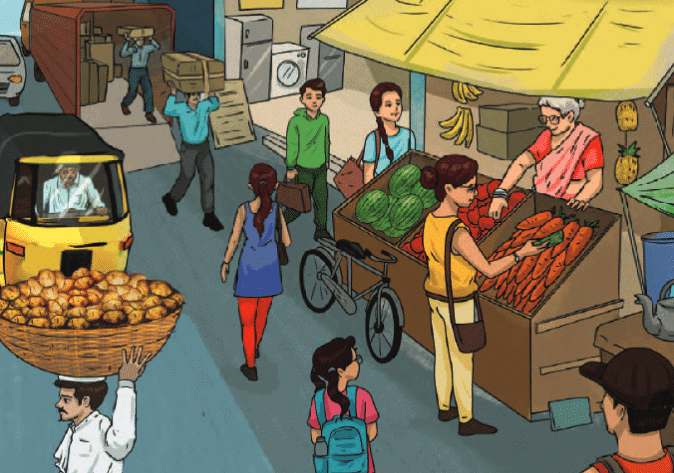 Scene of a Market
Scene of a Market
In this chapter, we will explore how markets function, their role in society, and how they have evolved over time.
What is a Market?
A market is a place where people buy and sell goods and services, called bazaar, haat (Hindi), or marukatte (Kannada).
- Markets can be physical (like a shop) or online (via apps or websites).
- They provide goods and services to individuals, households, and businesses.
- Example of a market from 16th century India: Hampi Bazaar was one of the most flourishing markets of the Vijayanagara Empire, reflecting the prosperity of the city. It sold a wide range of goods such as grains, seeds, milk, oil, silk, animals (like cows, rabbits, horses), and even birds.
- Craftsmen also displayed fine jewelry, textiles, and precious stones like rubies, pearls, and diamonds. Foreign travelers like Domingos Paes praised Hampi as “the best-provided city in the world,” while Fernao Nuniz marveled at the abundance of goods despite the barren surroundings.
- The bazaar showcased both essential needs (like food, clothing, and shelter items) and wants (luxury goods and ornaments), making it a true center of vibrant trade.
 Hampi Bazaar Today
Hampi Bazaar Today
- A buyer who wants to purchase.
- A seller who offers goods or services.
- A price, the amount agreed for the transaction (buying/selling).
- Buyers and sellers often negotiate or bargain to agree on a fair price.
Prices and Markets
Prices are set by how buyers and sellers interact in a market. Prices are generally determined by the interaction between demand from buyers and supply by sellers.
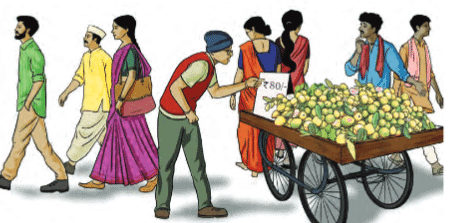 Scenarios:
Scenarios:
- High Price: If the price is set too high, few buyers may purchase, prompting the seller to lower the price.
- Low Price: If the price is set too low, many buyers may purchase, but the seller might raise the price to earn more.
- Just Right Price: The price that balances what buyers can pay and what the seller needs to earn. This price is set over time, influenced by demand (how much buyers need) and supply (how much sellers offer)
- As sellers observe buyer behavior, they can assess how much of a product to supply in the future to meet demand while ensuring fair prices.
- Vegetables are cheaper at night in weekly markets because sellers want to clear stock before it spoils.
- Garment stores discount woollen clothes at winter’s end to sell leftover stock.
- If a seller sets the price at ₹80/kg, but buyers think it’s too high, they offer a lower price. The seller may refuse if it’s not profitable.
- They negotiate until they agree on a mutually agreeable price. If they don’t agree, no transaction happens.
Markets Around Us
Markets exist in many forms and places, serving different needs. Here are the different type of Markets Around Us.
Physical and Online Markets
Physical markets:- A physical market is a place where buyers and sellers meet in person to exchange goods or services for money.
- Examples: weekly markets, haats (vendors selling vegetables, essential items, and handicrafts), local shops, street food vendors, and malls with multiple stores.
- Some services, like tailoring, require a physical presence for interaction.
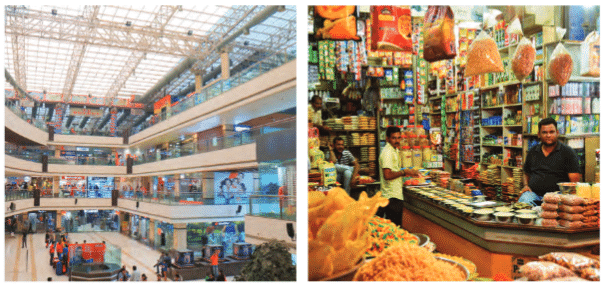 Physical Markets
Physical Markets
- Buyers and sellers transact through apps or websites, even from far away.
- Goods like books, clothes, furniture, groceries, or electronics (TVs, phones) can be bought and delivered to your doorstep.
- Services like online classes are also available.
- Manufacturers buy components online for production.
- Payments are made online, making it convenient.
- Physical: Buyers can see and touch goods, but it takes time to visit. Sellers meet customers but need a shop.
- Online: Convenient and offers more choices, but buyers can’t touch goods, and sellers face high competition.
Domestic and International Markets
Domestic markets:- Buying and selling happens within a country’s borders.
- Example: Paper for this textbook was bought from paper mills in India.
- Trade happens across countries through exports (selling goods to another country) or imports (buying goods from another country).
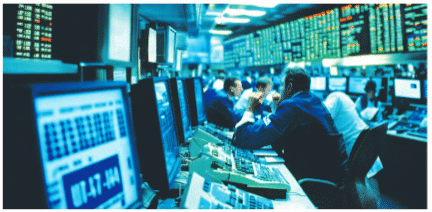 Stock Market
Stock Market
- India exports: software (North America), chemicals (South America), pharmaceuticals (Africa), machinery (Europe), petroleum (West Asia).
- India imports: aircraft (North America), copper ores (South America), diamonds (Africa), electrical equipment (Europe), crude petroleum (West Asia), vegetable oils (South East Asia).
- In 2024, India was the world’s largest importer of vegetable oils (palm, sunflower, soybean) from Malaysia, Indonesia, and Thailand.
Wholesale and Retail Markets
Several participants play their role in the smooth functioning of the markets. 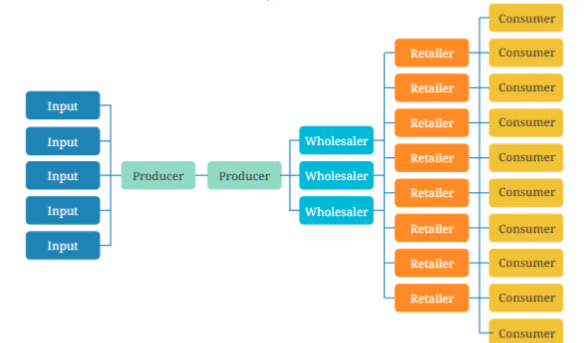 Wholesale Retail Markets
Wholesale Retail MarketsWholesale markets:
- Wholesalers buy large quantities of goods from producers (e.g., grains, vegetables from farms) and store them in warehouses or cold storage for perishables.
- Goods are sold in mandis or wholesale markets (e.g., Khari Baoli for spices, Bengaluru flower market).
- Wholesale markets also exist for chemicals, electronics, construction materials, and automotive parts.
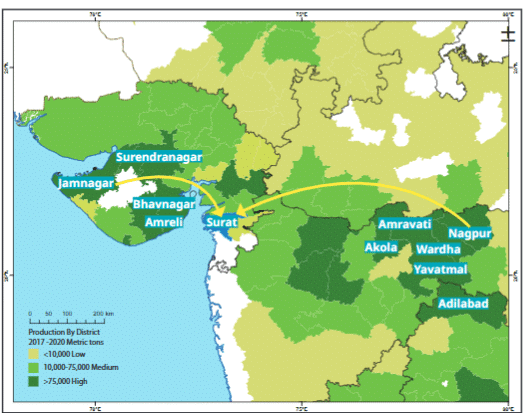 Supply of Raw Cotton to Surat
Supply of Raw Cotton to Surat
- Retailers buy from wholesalers and sell smaller quantities to consumers for personal use.
- Examples: grocery stores, garment shops, salons, movie theatres, restaurants.
- Retailers make goods and services easily available to households.
- Help wholesalers reach retailers when distances or terrains are challenging, like middlemen in the AMUL milk story from Grade 6.
- Manufacturers send goods to aggregators (businesses running online apps/websites).
- Consumers buy through the app, and aggregators pack and deliver the goods.
- Asia’s oldest textile hub, with factories making cotton and synthetic textiles.
- Raw cotton comes from mandis in Maharashtra and Gujarat, processed into fabric or garments through weaving and dyeing.
- Wholesalers distribute to retailers across India and internationally, ensuring steady supply.
- Surat’s diamond industry and port/highway networks also boost trade.
The Role of Markets in People’s Lives
Markets enable transactions between producers and consumers, allowing individuals, households, and businesses to obtain goods and services they need but cannot create themselves. Without markets, crucial items like rice, wheat, or cloth would not be available, leading to shortages.
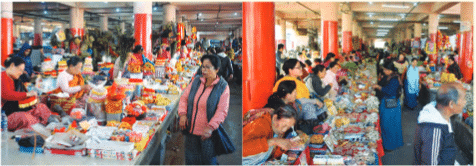 Ima Keithal in Manipur
Ima Keithal in Manipur
- Example: Aakriti, an artist, struggles to find buyers for her paintings because art has fewer local buyers, unlike guavas. Artists can use online platforms or galleries to reach buyers.
- Markets build relationships: Families trust tailors, jewelers, or grocers for generations, sometimes settling accounts monthly. Ima Keithal in Manipur, run by 3000 women, sells vegetables, clothes, and crafts, providing income and uniting communities.
- Traditions: In South India, sellers give free haldi and kumkum with purchases as a sign of good wishes.
How Markets Benefit Society
- Markets respond to consumer needs, improving products and society.
- Example: When consumers demand energy-efficient refrigerators, producers make them, saving electricity and helping the environment.
- Markets encourage innovation and better products based on what people want.
Government’s Role in the Market
Markets work through the interaction of demand from buyers and supply from sellers. However, when this doesn't work well, the government steps in to ensure fair pricing and monitor the interaction between consumers and producers.
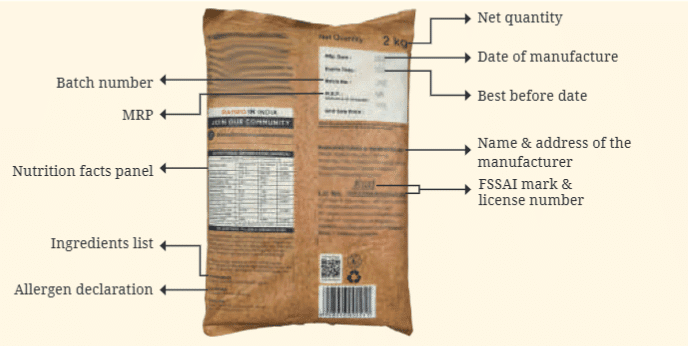 Label Behind Packet
Label Behind Packet
1. Controlling Prices for Protecting Buyers and Sellers
The government sets price limits:- Maximum prices for essentials like lifesaving drugs to protect buyers.
- Minimum prices for crops like wheat or maize to ensure farmers don’t lose money.
- Minimum wages to ensure fair pay for workers.
Prices must balance: too low, producers stop making goods; too high, buyers can’t afford them. Example: When onion supply drops, prices rise. The government may import onions or control prices to help consumers.
2. Ensuring Quality and Safety Standards
- The government checks that goods and services meet quality and safety standards.
- Example: For medicines, the government approves drugs and tests samples to ensure they are safe, protecting consumer health.
- It also monitors weights and measures of packaged goods to ensure correct quantities.
- Historical example:Kautilya’s Arthaśhāstra required traders to give extra ghee to buyers to account for losses in measuring, showing early consumer protection.
3. Mitigating the External Effects of Markets
- Markets can harm the environment, like factories polluting during production.
- The government makes rules to control these effects, e.g., regulating single-use plastics to reduce pollution and health risks.
4. Providing Public Goods
- Public goods like parks, roads, or policing don’t generate profit, so producers don’t provide them.
- The government provides these to ensure citizens’ welfare, as guaranteed by the Constitution.
- Too many rules can disrupt markets, so the government must balance regulation and freedom.
How Can Consumers Assess the Quality of Products and Services?
- Consumers need to check the quality of goods to make good buying choices.
- Example: Buying marbles for a competition, you’d check price, size, strength, and color to win.
- For products like gram flour, consumers look for quality signs on packages.
- Word of mouth: Family or friends recommend trusted products.
- Online reviews: Feedback from other buyers helps decide online purchases.
Let’s See What Each of These Labels Mean
Government certificationson products show they meet quality standards:- FSSAI (Food Safety & Standards Authority of India): On food packets, it shows the food is tested and safe to eat.

- ISI Mark (Indian Standards Institution by Bureau of Indian Standards): On electrical appliances, tires, or paper, it ensures quality and safety.

- AGMARK (Agriculture Mark): On vegetables, fruits, pulses, or honey, it certifies quality for agricultural products.
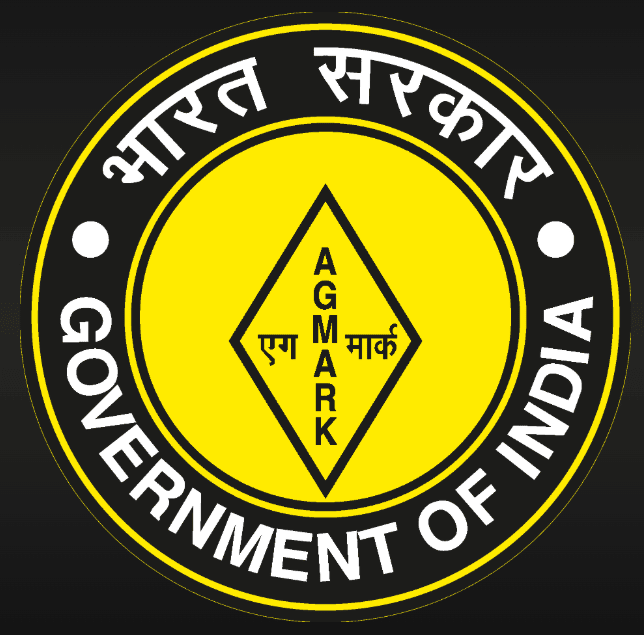
- BEE Star Rating (Bureau of Energy Efficiency): On electronics like TVs or ACs, more stars mean less electricity use, saving money and helping the environment.

Points to Remember
- Markets enable buying and selling at a price set by demand and supply.
- Participants like manufacturers, wholesalers, distributors, and retailers ensure goods reach consumers.
- Markets connect people, promote traditions, and exchange ideas.
- The government regulates markets for fair prices, quality, safety, and environmental protection.
- Consumers assess quality using certifications (FSSAI, ISI, AGMARK, BEE) and reviews.
Difficult Words
- Needs: Things people must have to survive, like food or shelter.
- Wants: Things people desire but don’t need, like toys.
- Market: A place where people buy and sell goods and services.
- Trade: Buying, selling, or exchanging goods and services.
- Price: The amount paid for goods or services, agreed by buyer and seller.
- Transaction: The act of buying or selling something.
- Negotiate: Discussing to agree on a price or deal.
- Demand: The amount of goods or services buyers want at a price.
- Supply: The amount of goods or services sellers offer at a price.
- Physical market: A market where buyers and sellers meet in person.
- Online market: A market where transactions happen through apps or websites.
- Domestic market: Trade within a country’s borders.
- International market: Trade across countries.
- Export: Selling goods to another country.
- Import: Buying goods from another country.
- Wholesaler: A person buying large quantities from producers to sell to retailers.
- Retailer: A person selling small quantities to consumers.
- Distributor: A person supplying goods from wholesalers to retailers.
- Aggregator: A business selling goods online from multiple sellers.
- Cold storage: Warehouses keeping perishable goods fresh at low temperatures.
- Public goods: Services or items available to all, like roads or parks.
- Certification: A mark showing a product meets quality standards.
- FSSAI: Food Safety & Standards Authority of India, ensuring food safety.
- ISI Mark: A quality mark for appliances, tires, or paper.
- AGMARK: A quality mark for agricultural products.
- BEE Star Rating: A mark showing energy efficiency of electronics.
FAQs on Understanding Markets Class 7 Notes Social Science Chapter 12 Free PDF
| 1. What is a market and why is it important? |  |
| 2. What are the different types of markets? |  |
| 3. How do markets benefit society? |  |
| 4. What role does the government play in markets? |  |
| 5. How do online markets differ from physical markets? |  |
















